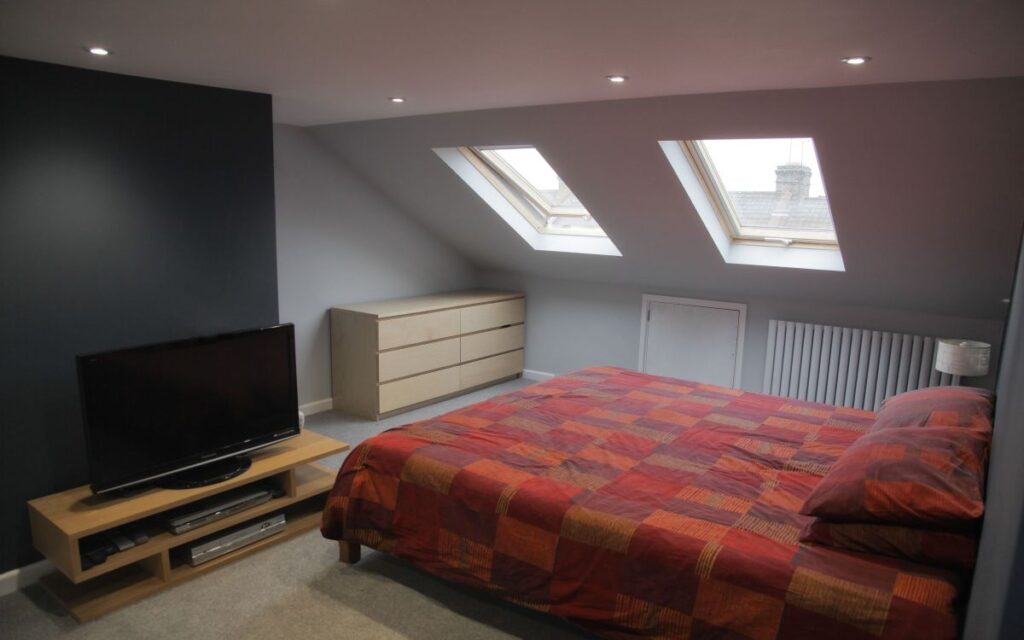Loft conversions are an excellent way to add extra living space to your home without needing a costly extension. However, when dealing with a low ceiling loft conversion, the challenge lies in making the space feel open, functional, and aesthetically pleasing despite the limited headroom.
Fortunately, with smart design strategies and creative thinking, you can transform your low-ceiling loft into a cosy, stylish, and highly usable area. Whether planning a bedroom, home office, or relaxation space, this guide will provide unique and practical low ceiling loft conversion ideas to help you maximise every inch.
Choosing the Right Layout for a Low Ceiling Loft
Planning the right layout is one of the most important aspects of a successful loft conversion with a low ceiling. The placement of furniture and functional zones can make a huge difference.
- Position Beds and Seating in the Lowest Parts: If you’re converting the loft into a bedroom, place the bed under the lowest section of the ceiling where standing height isn’t necessary.
- Create Built-In Storage: Utilise the lower sections of the loft for built-in wardrobes, shelving, or storage units to avoid wasting space.
- Centralise Standing Areas: Keep walkways and frequently used spaces, such as desks or dressing areas, in the highest part of the loft with greater ceiling height.
Utilising Clever Lighting Solutions
Lighting is crucial in making a low ceiling loft more spacious and inviting. Here are some lighting solutions to consider:
- Recessed or Flush-Mounted Lights: Avoid hanging lights or pendant fixtures that make the ceiling feel even lower. Instead, opt for recessed LED lights or flush-mounted fittings.
- Skylights and Roof Windows: Adding skylights or dormer windows can flood the loft with natural light, making it feel brighter and more open.
- Wall-Mounted Lighting: Using wall sconces or strip lighting can create a cosy atmosphere without encroaching on ceiling height.
- Mirrors and Reflective Surfaces: Placing mirrors strategically helps to bounce light around the space, giving the illusion of more height.
Must Read: Small Loft Bedroom Ideas – Maximise Your Space
Maximising Storage in a Low Ceiling Loft Conversion
Storage can be challenging in a loft with restricted height, but with some smart solutions, you can keep your space tidy and organised.
- Eaves Storage: Use the lowest areas of the loft for built-in cupboards, drawers, or storage benches.
- Custom-Fitted Wardrobes: Tailor-made wardrobes that fit the sloping roofline can maximise space efficiently.
- Under-Bed Storage: Utilise the space beneath the bed for extra storage, such as pull-out drawers or built-in compartments.
- Floating Shelves: Wall-mounted shelves keep the floor clear while providing additional storage.
Selecting the Best Furniture for a Low Ceiling Loft
When furnishing a low-ceiling loft, opt for pieces that complement the space without overwhelming it.
- Low-Profile Beds: A platform or futon-style bed keeps the sleeping area comfortable without taking up too much vertical space.
- Compact Desks and Seating: Choose desks, chairs, and sofas that have a sleek, low-profile design.
- Foldable or Multi-Purpose Furniture: Items like fold-out desks, wall-mounted tables, or extendable seating help maximise flexibility.
- Bespoke Furniture: Custom-built furniture that follows the roof’s contours makes the best use of available space.
Creating the Illusion of Height in a Low Ceiling Loft
If your loft conversion has a low ceiling, making it appear taller can greatly enhance the overall look and feel of the space.
- Vertical Stripes or Panelling: Decorating walls with vertical stripes or wooden panelling draws the eye upward, creating the illusion of height.
- Light Colours for Walls and Ceilings: White, light grey or pastels make the room more open and airy.
- Minimalist Décor: Avoid bulky or overly intricate decorations, making the space feel cluttered and smaller.
- Strategic Curtain Placement: Hanging curtains slightly higher than the actual window frame gives the impression of taller walls.
Heating and Ventilation Considerations
Lofts can often feel too hot in summer and too cold in winter, so temperature control is essential.
- Proper Insulation: High-quality insulation ensures your loft remains warm in winter and cool in summer.
- Roof Windows for Ventilation: Installing opening roof windows or vents helps with airflow, preventing the space from feeling stuffy.
- Compact Radiators or Underfloor Heating: If space is limited, underfloor heating is an efficient way to warm the room without taking up wall space.
- Portable Fans or Air Conditioning: A small, energy-efficient fan or air conditioner can help regulate temperature in warmer months.
Must Read: Loft Conversion Fire Door Rules & Regulations
Smart Colour and Material Choices
The materials and colours you use in your low ceiling loft conversion can significantly impact the perception of space.
- Matte Finishes: Matte walls and ceilings reduce glare and create a smoother, more spacious look.
- Glass and Acrylic Elements: Transparent materials like glass partitions or acrylic furniture help maintain an open feel.
- Light Wood Tones: Natural light woods like oak or ash brighten the space without overwhelming it.
- Minimalist Colour Palette: Stick to a cohesive colour scheme with a balance of soft neutrals and warm accents.
Unique Ideas for Different Loft Uses
If you’re wondering how best to use your low ceiling loft space, here are some great ideas:
- Cosy Bedroom: A low bed, soft lighting, and layered textiles create a snug retreat.
- Home Office: Position a desk near a skylight for a productive and inspiring workspace.
- Relaxation Nook: Craft a reading or meditation corner using bean bags, floor cushions, and a bookshelf.
- Children’s Playroom: Low ceilings are perfect for a child-friendly space filled with soft furnishings and creative décor.
- Guest Room: A compact sofa bed and foldable furniture make the loft a comfortable guest space.
Final Thoughts
A low ceiling loft conversion may present some challenges, but with careful planning, smart furniture choices, and effective lighting techniques, you can create a stylish and functional space. Maximising every inch and incorporating clever design tricks, your loft can become a valuable and beautiful addition to your home.
Ready to transform your loft? Start planning today and make the most of your space!
Read More Blogs At: The Home Designer
Frequently Asked Questions
What is the minimum ceiling height for a loft conversion?
Generally, a loft should have at least 2.2 metres of headroom, but creative design solutions can help maximise lower spaces.
How do I make a low ceiling loft feel bigger?
Light colours, mirrors, vertical stripes, and compact furniture can create the illusion of a more spacious area.
What type of lighting works best in a low ceiling loft?
Recessed lighting, wall sconces, and skylights are ideal for maximising brightness without taking up ceiling space.
Can I install a bathroom in a low ceiling loft?
Yes, by placing showers or bathtubs in the highest part of the loft and using space-saving fixtures, you can include a bathroom in your loft conversion.





